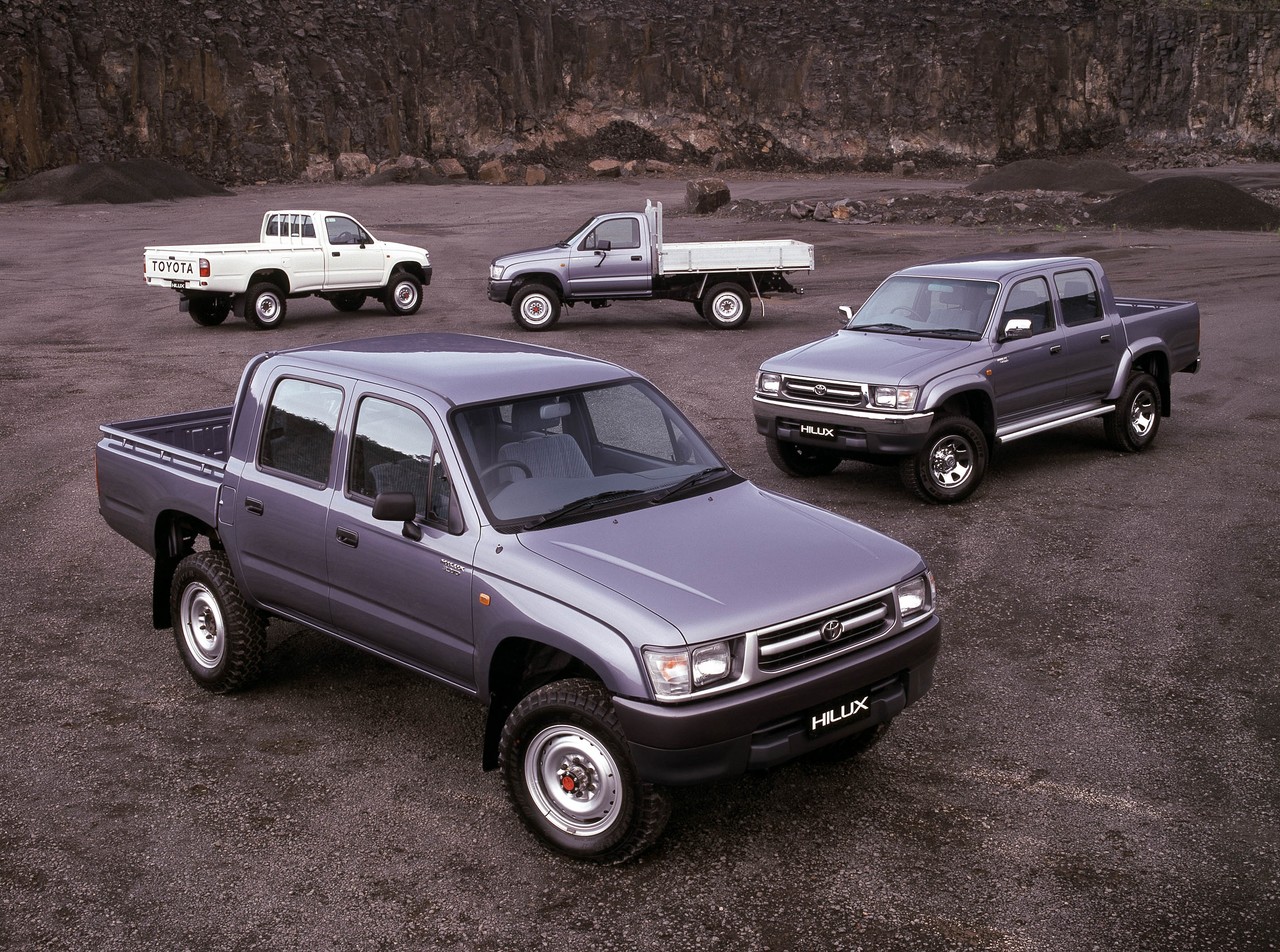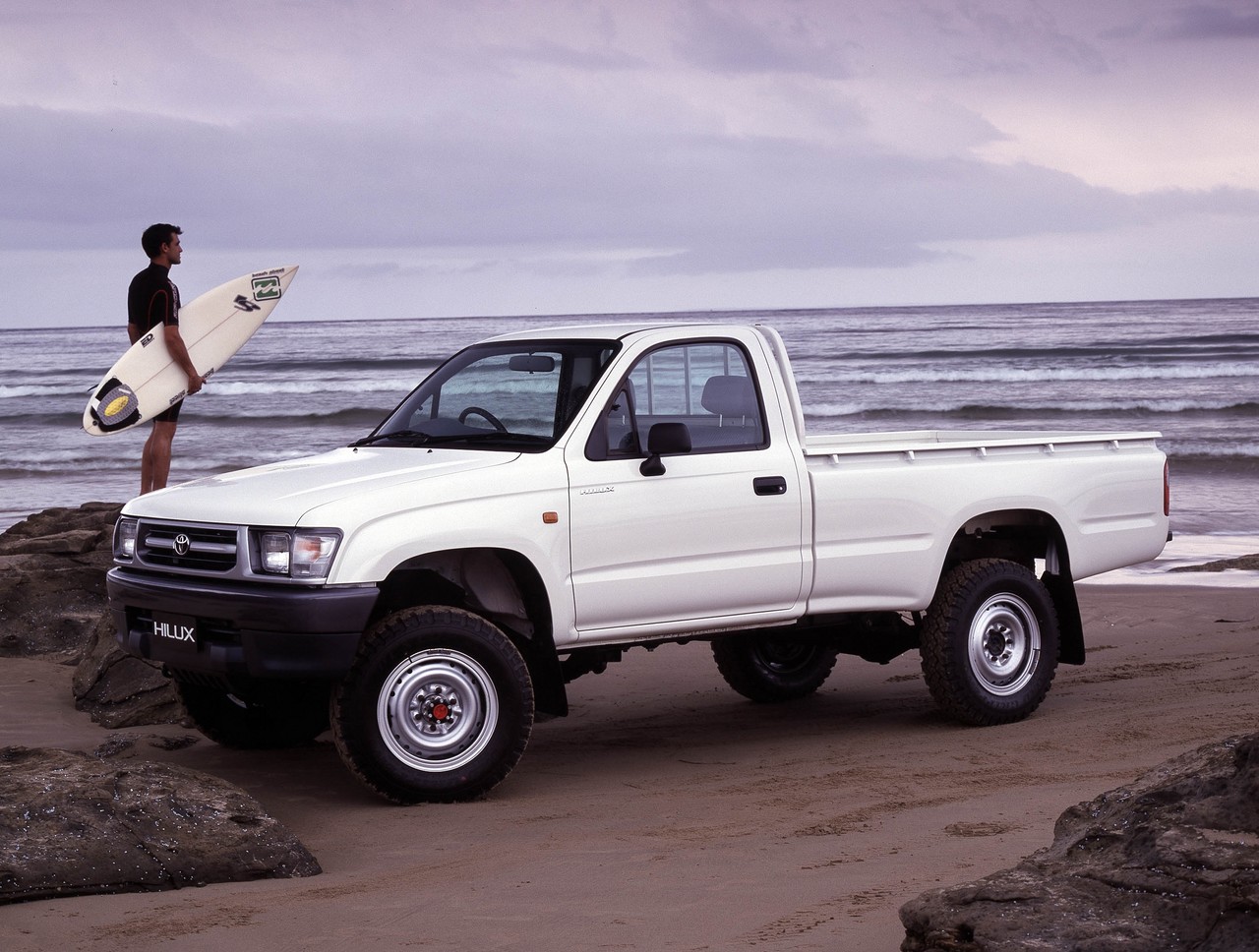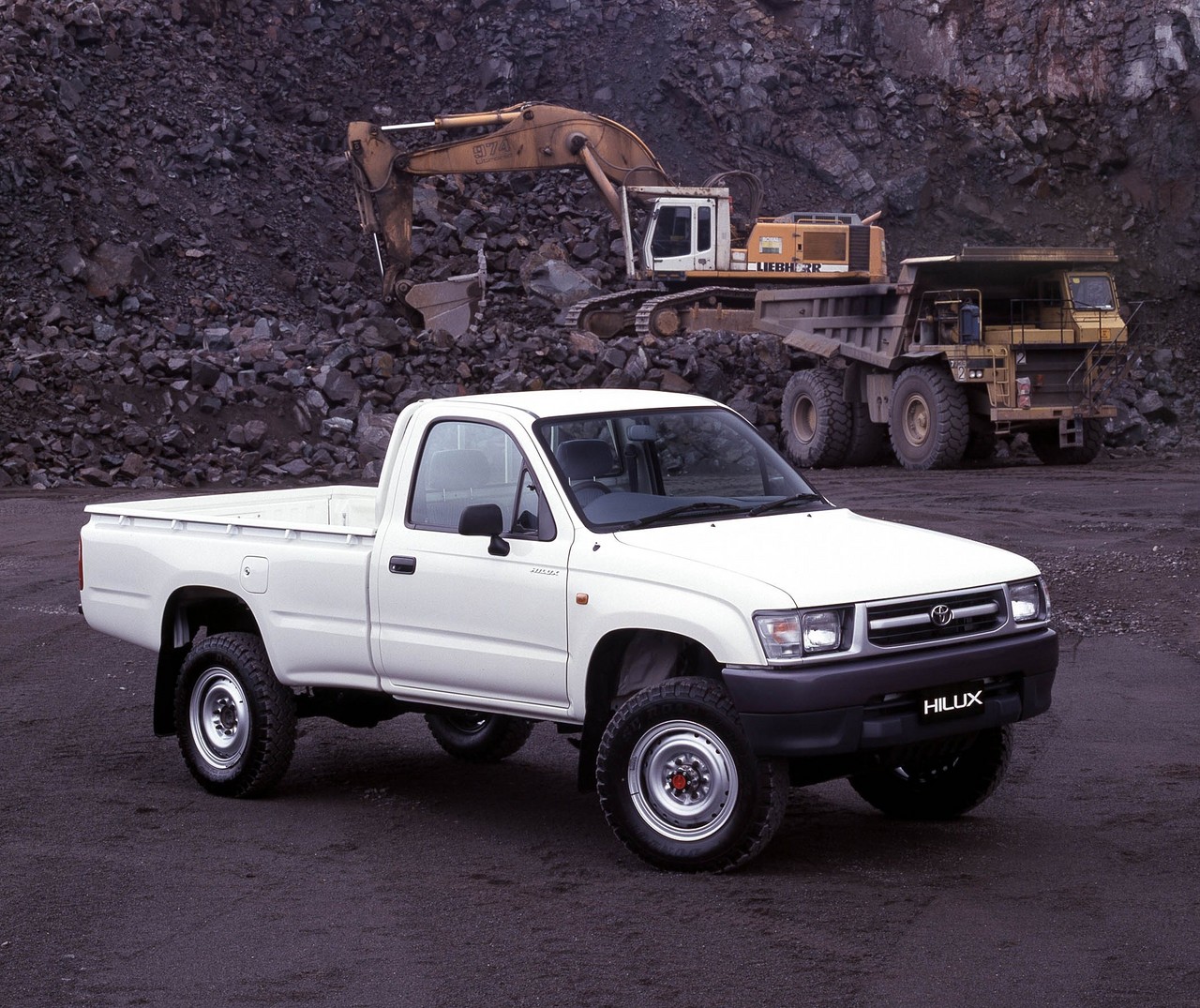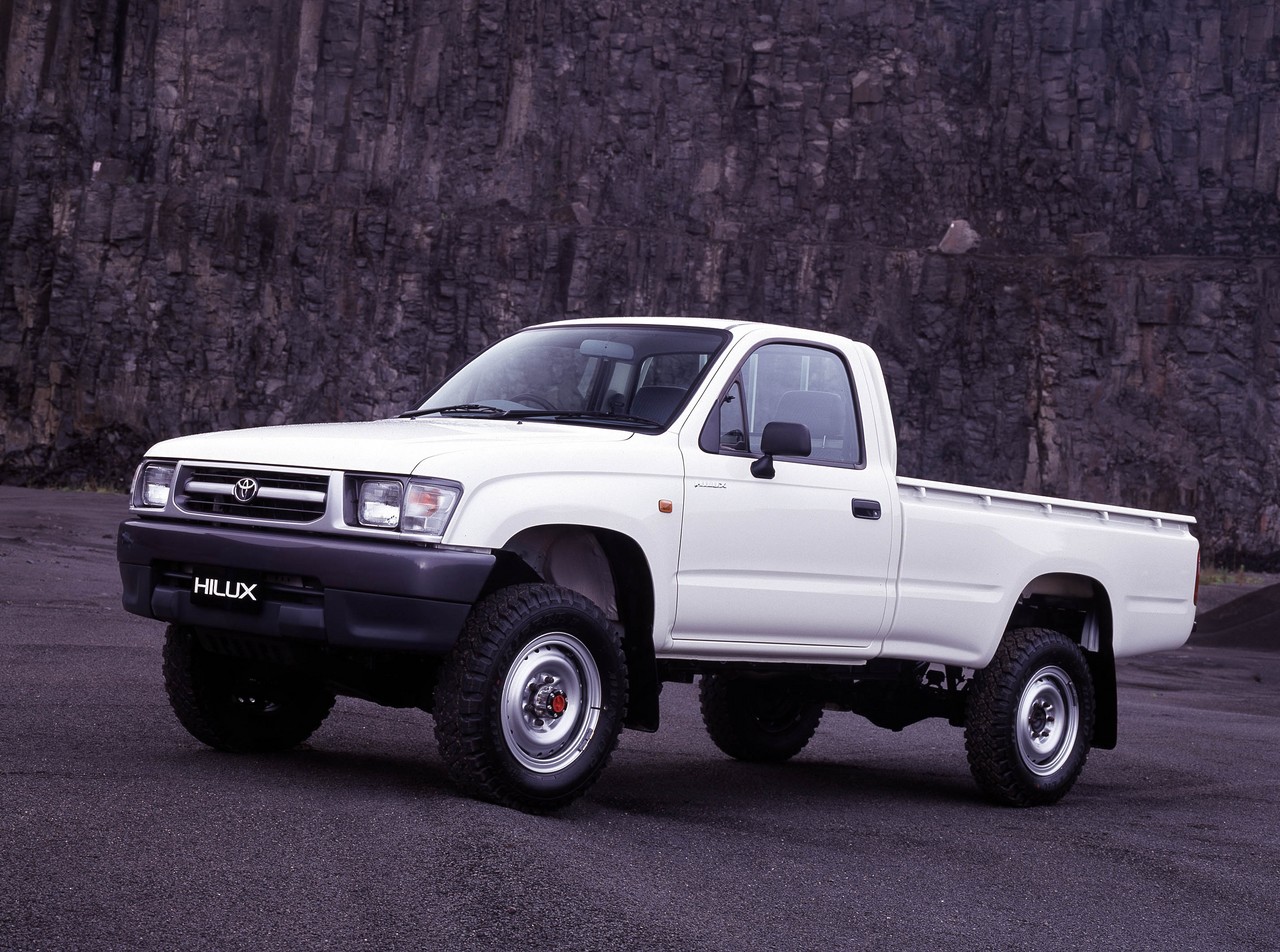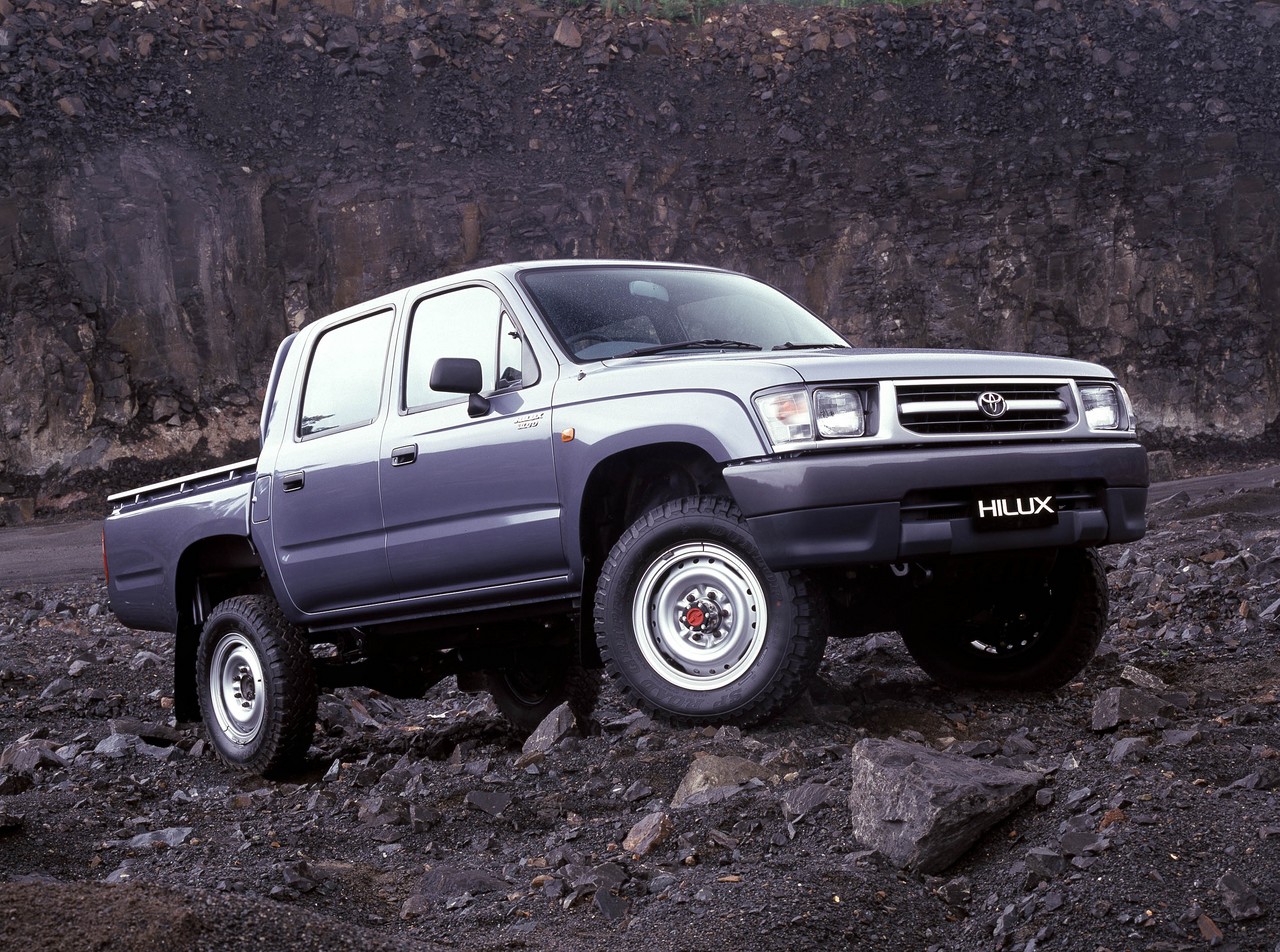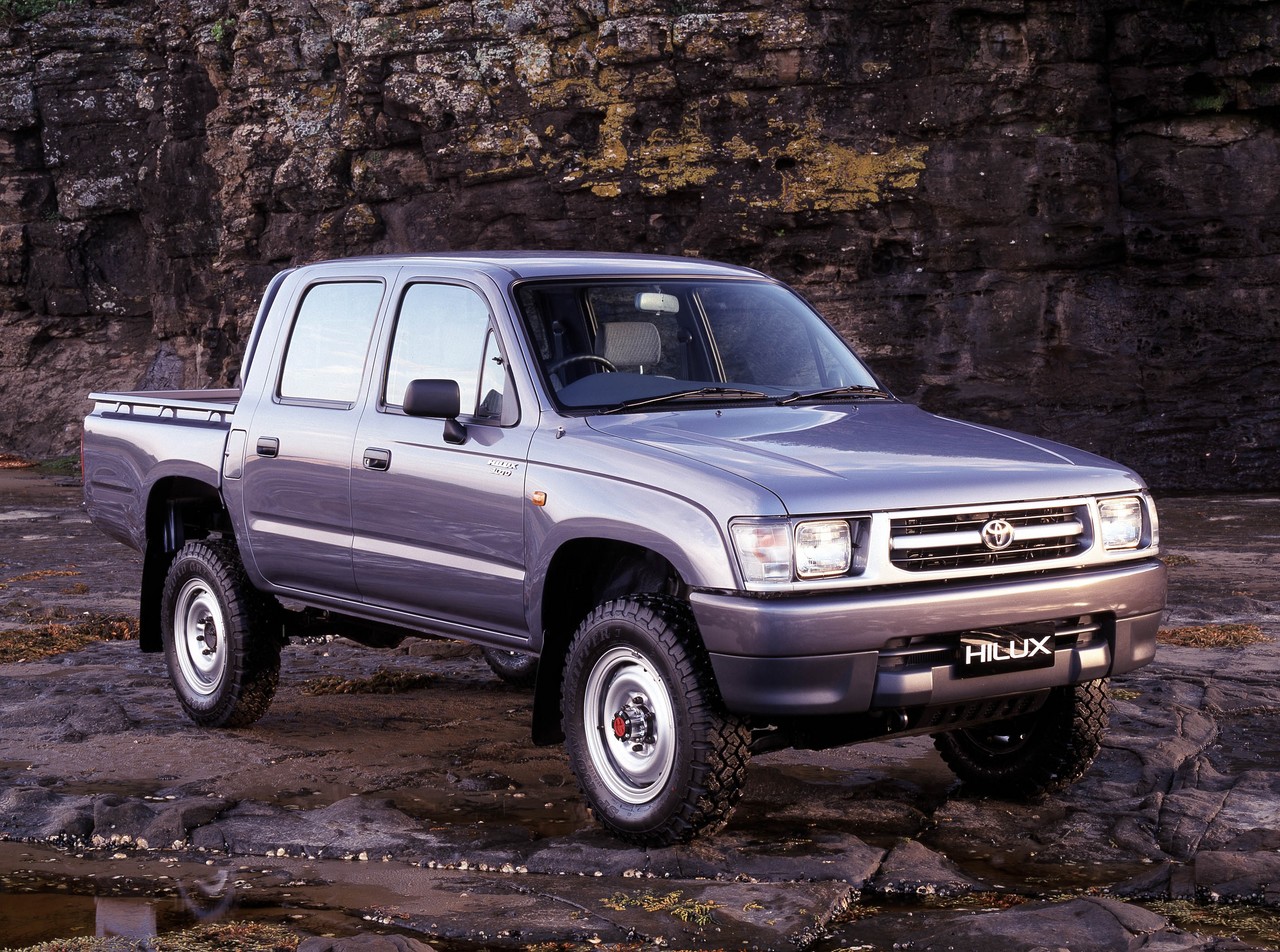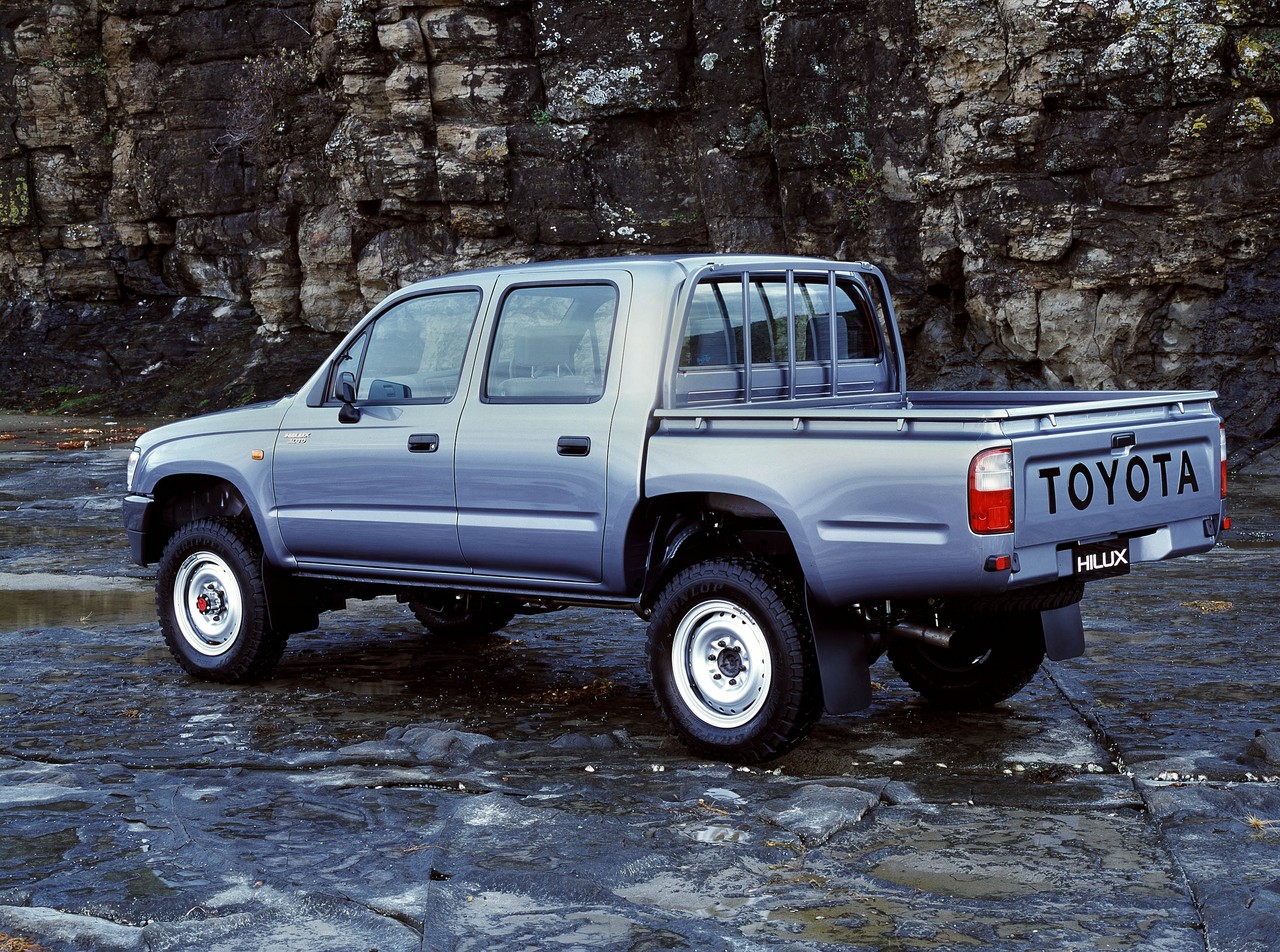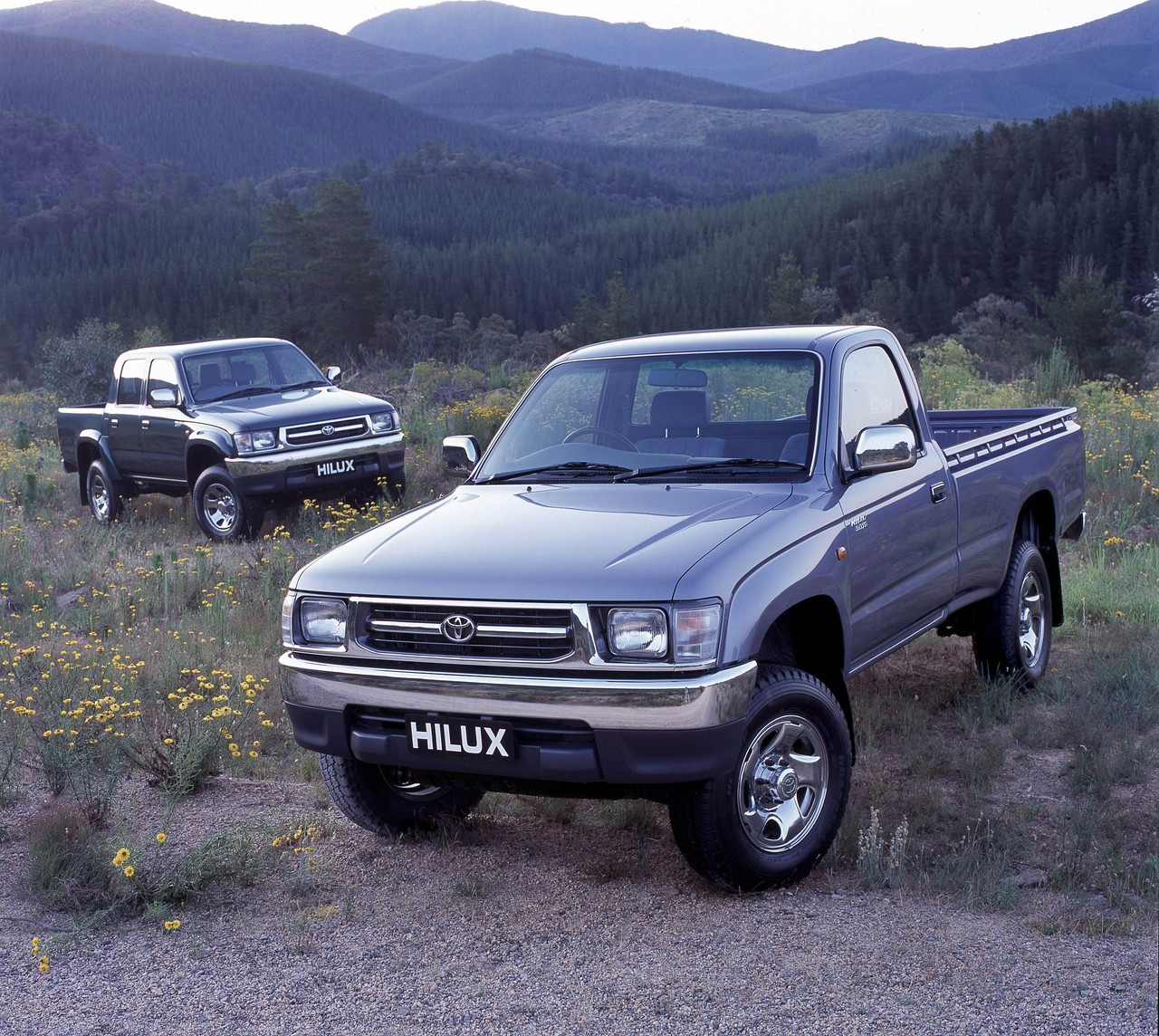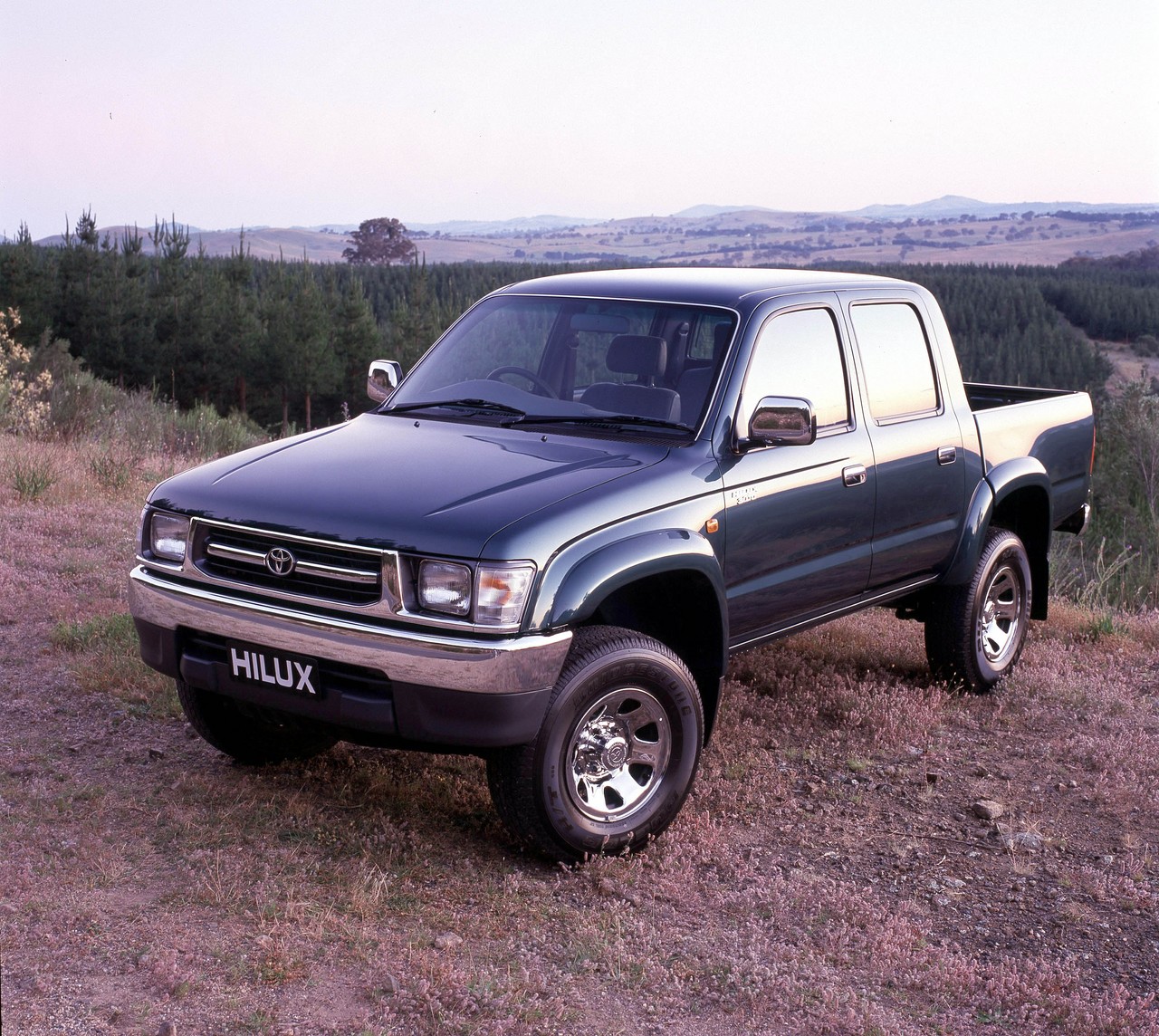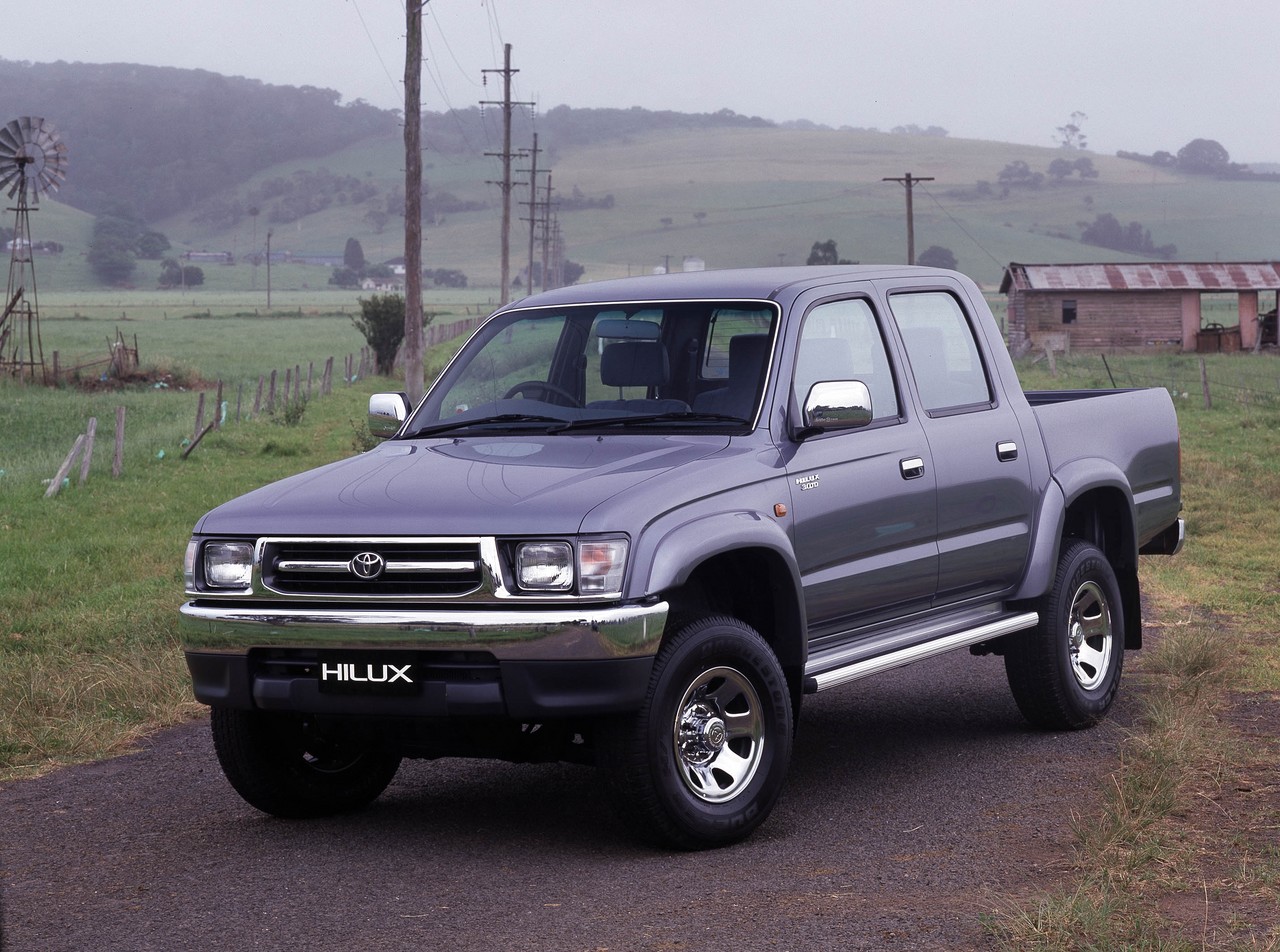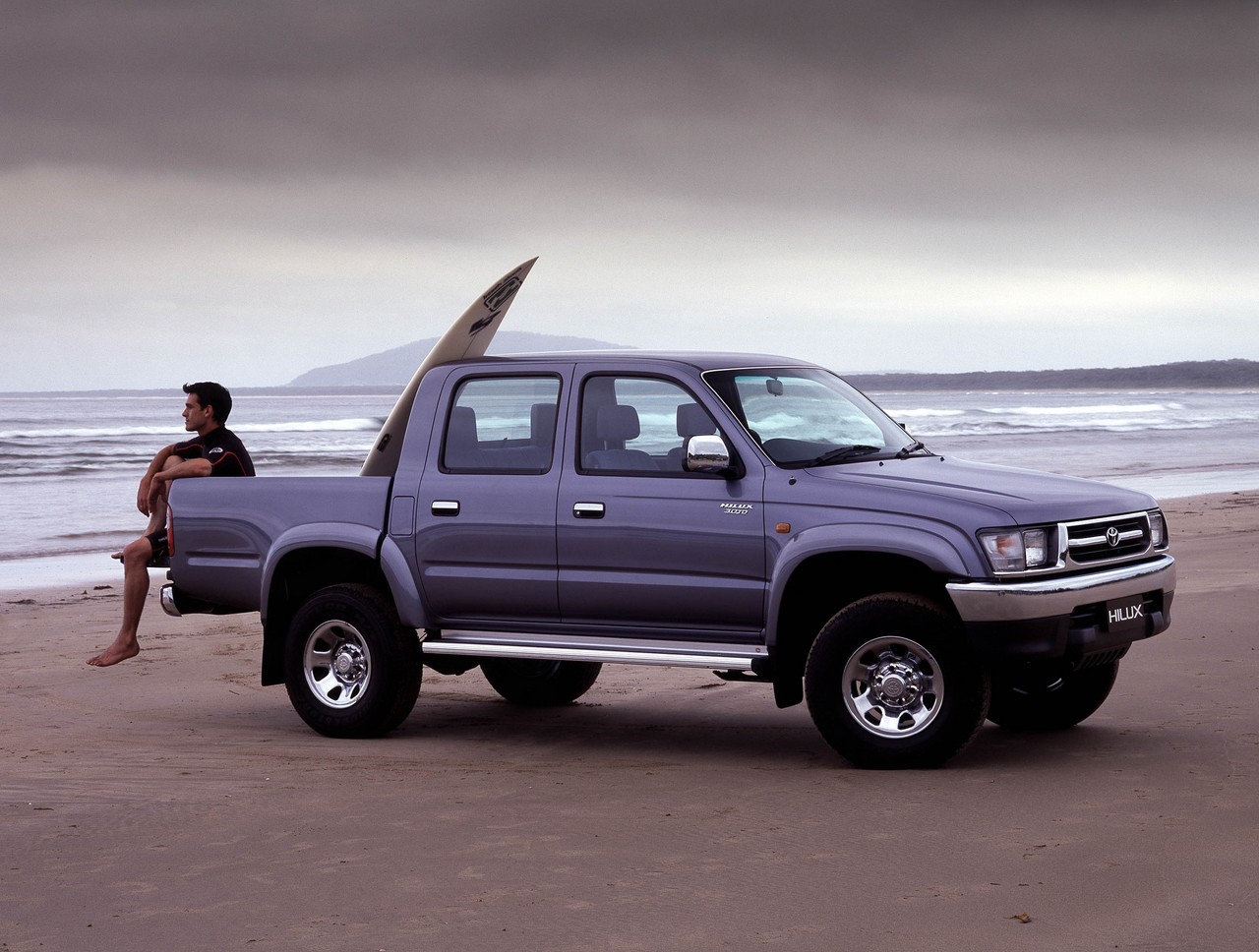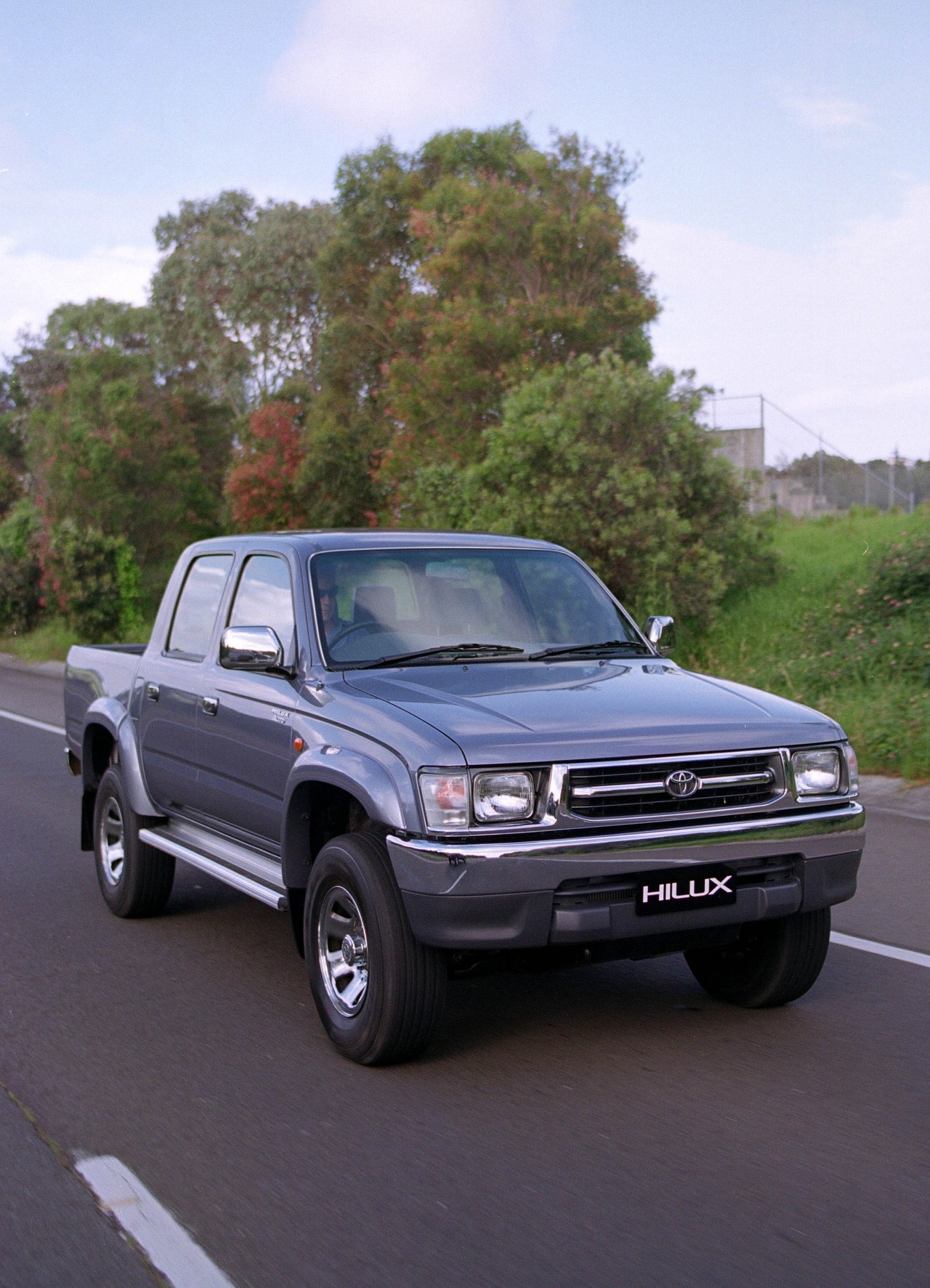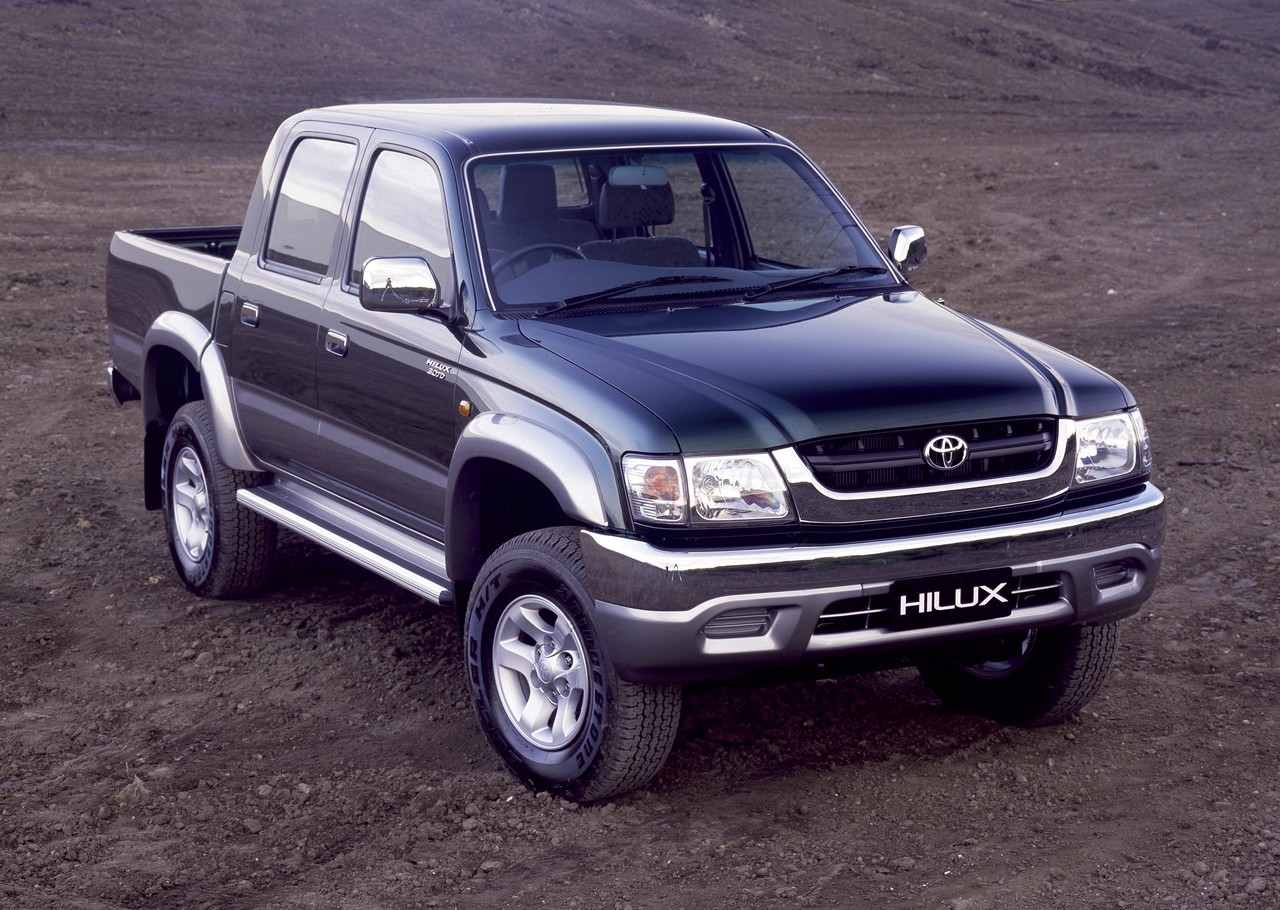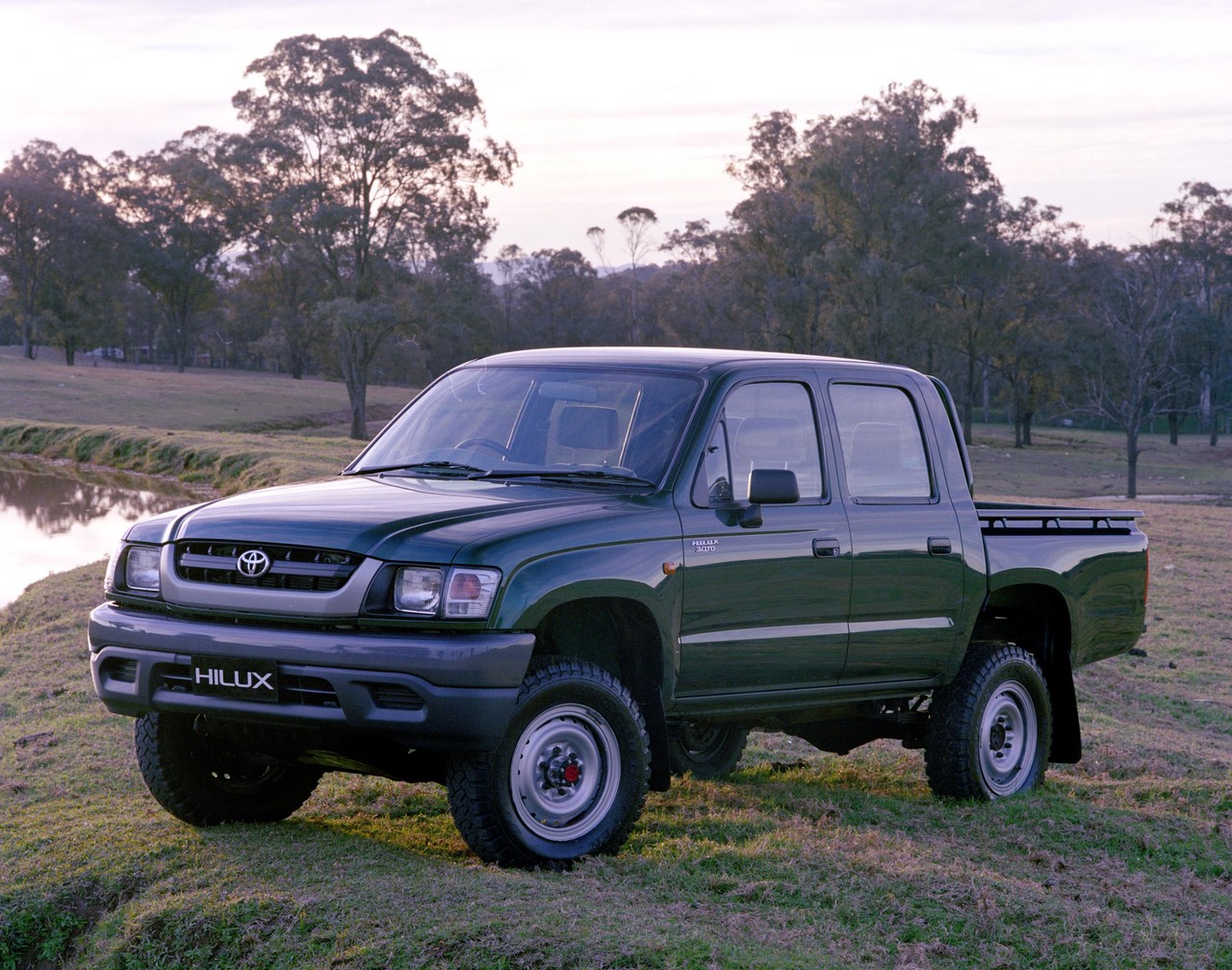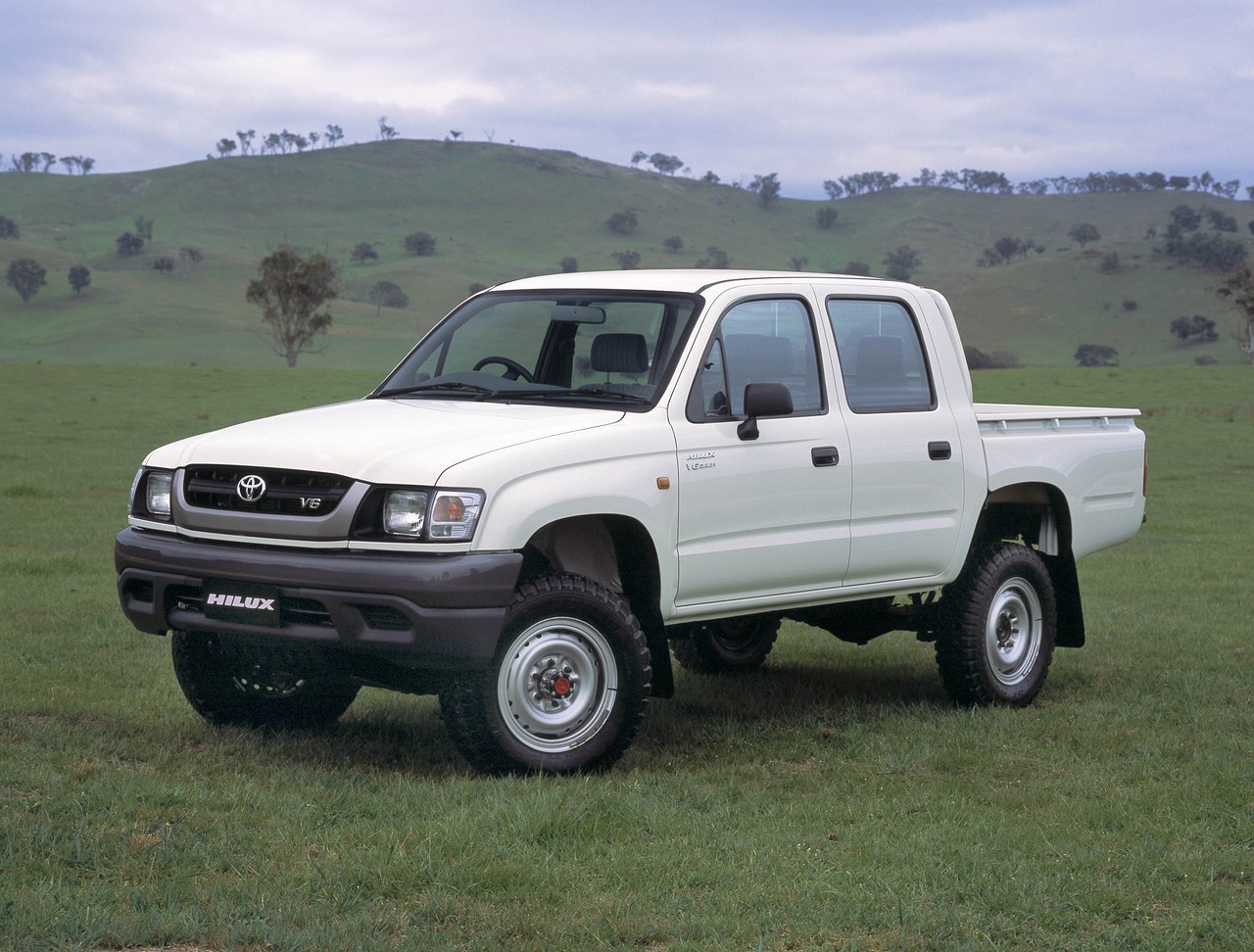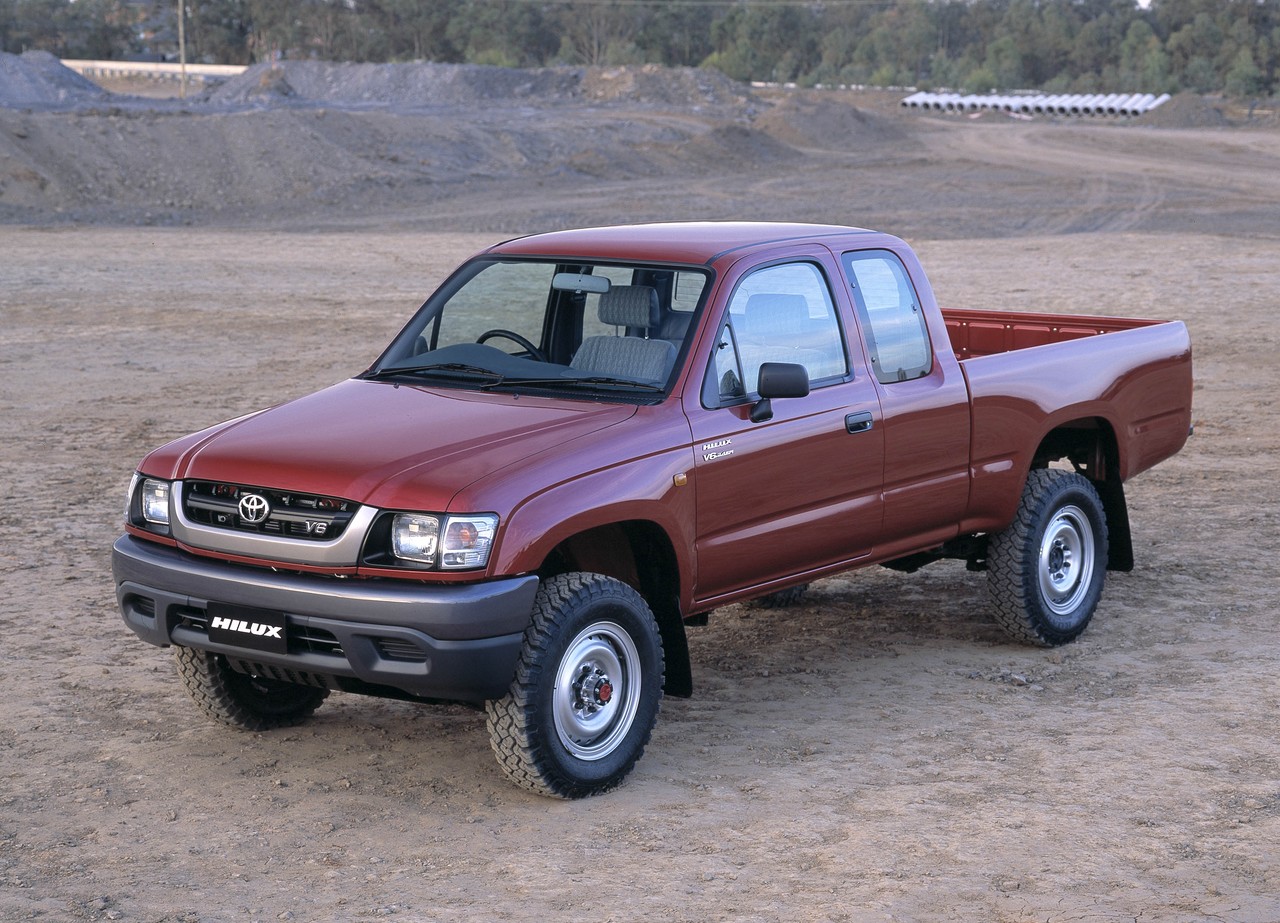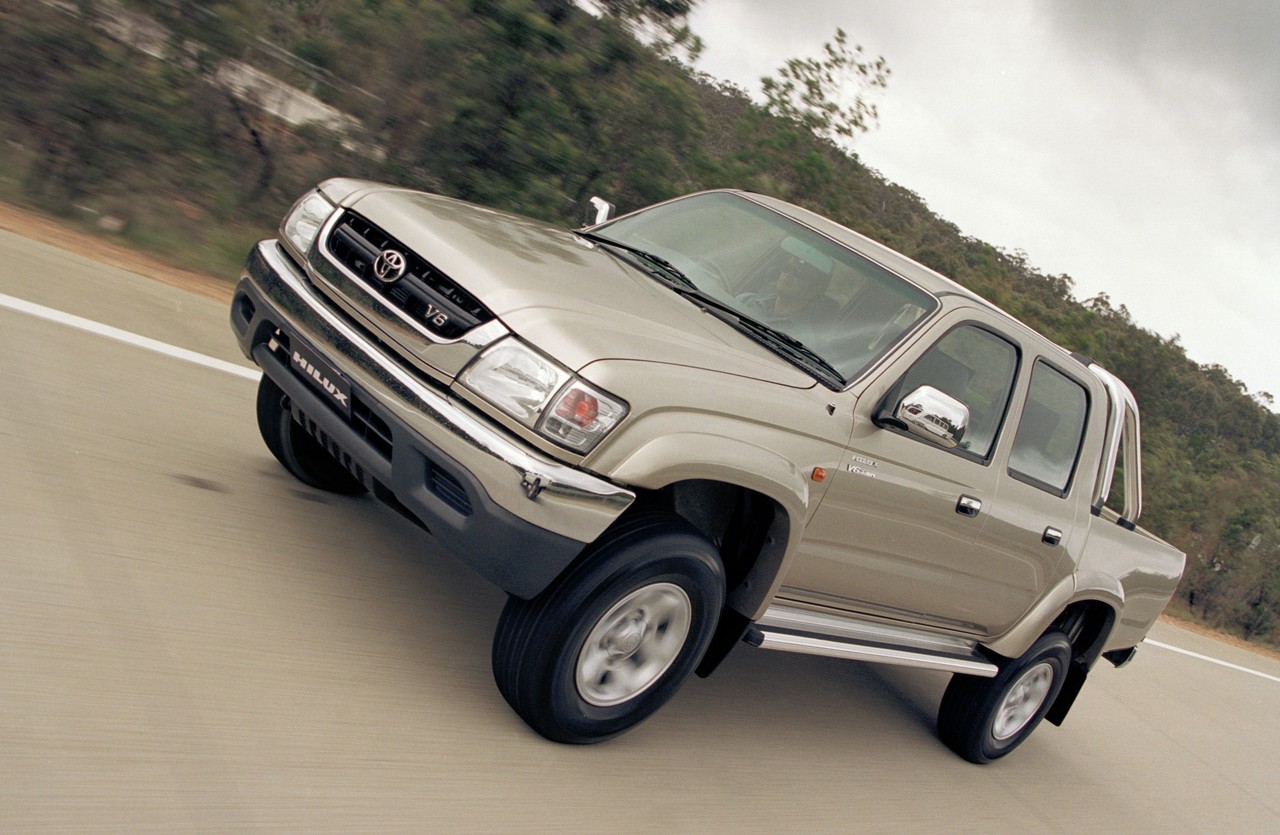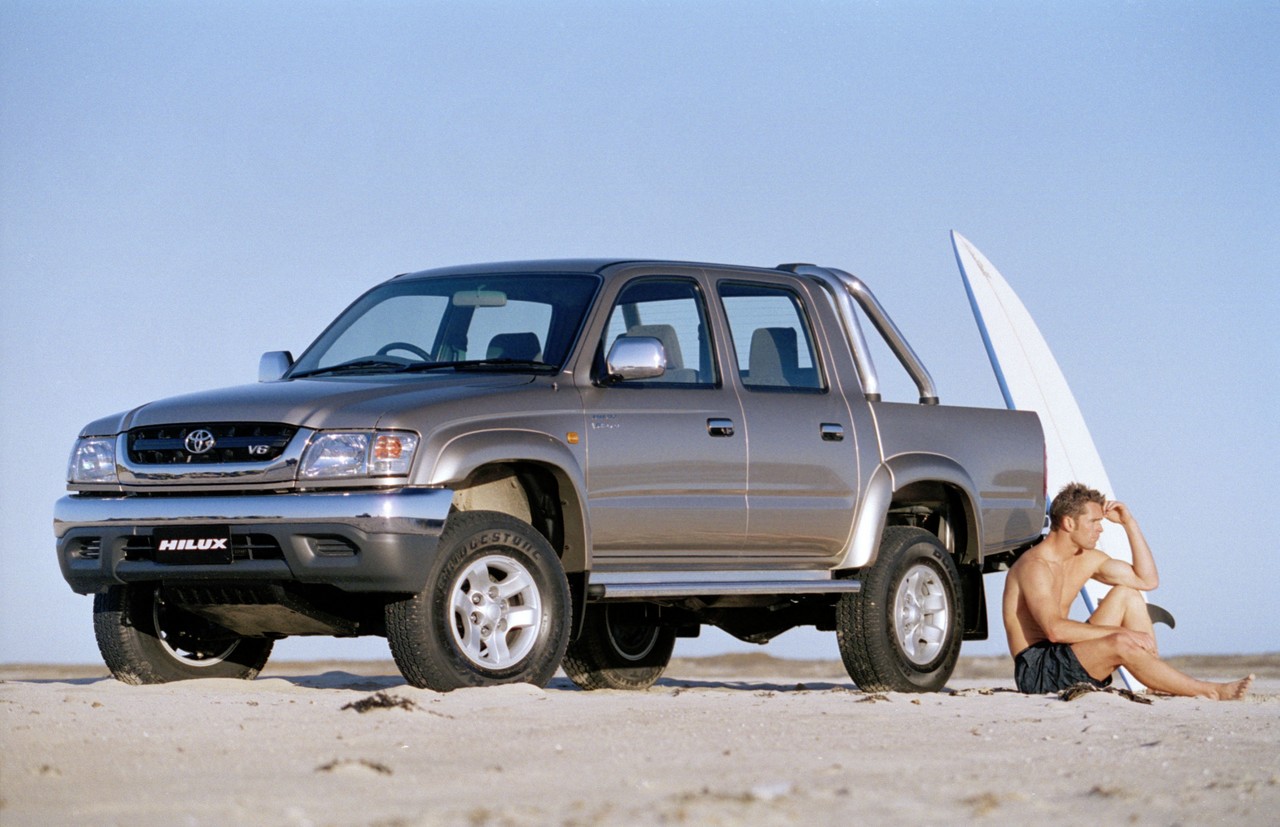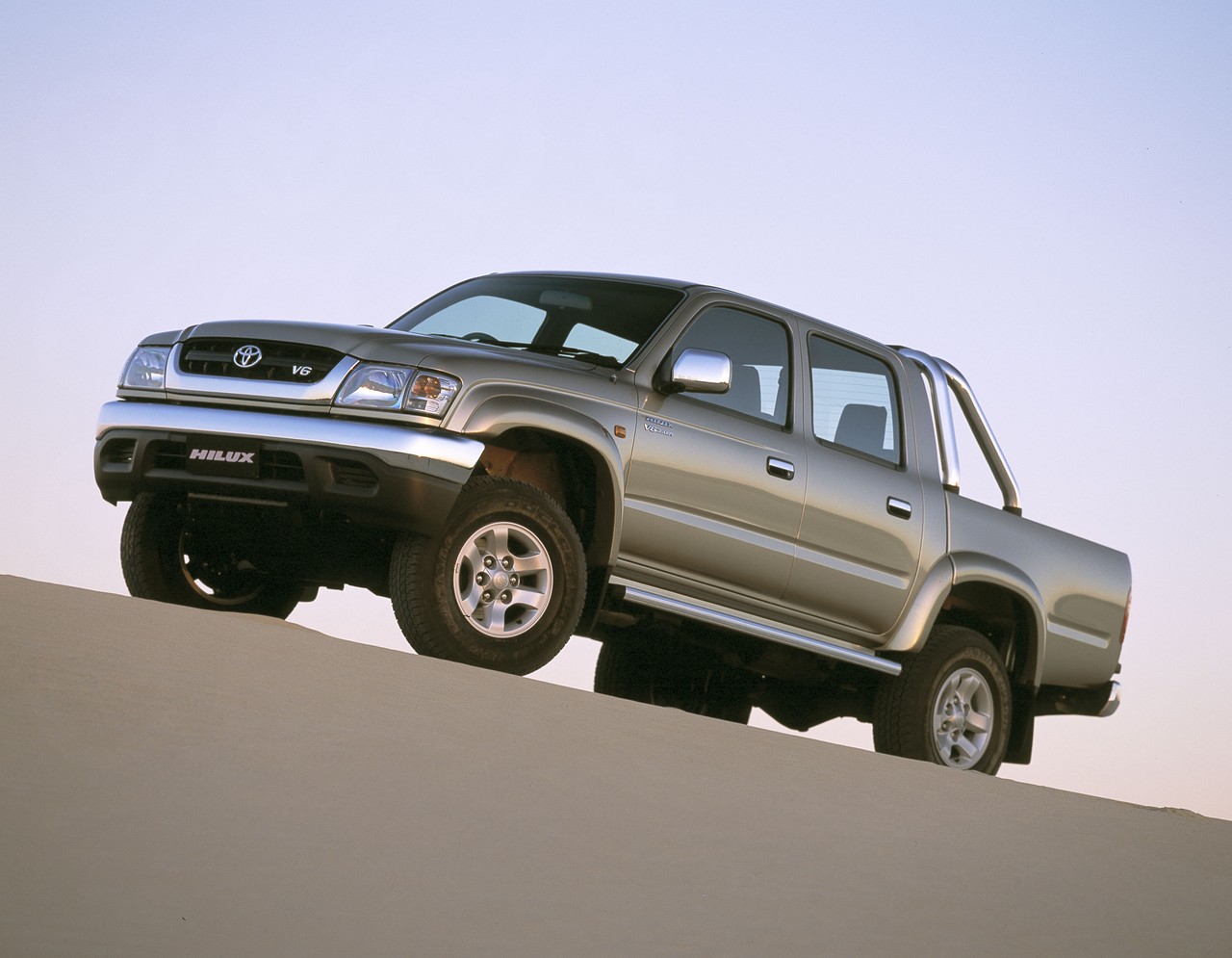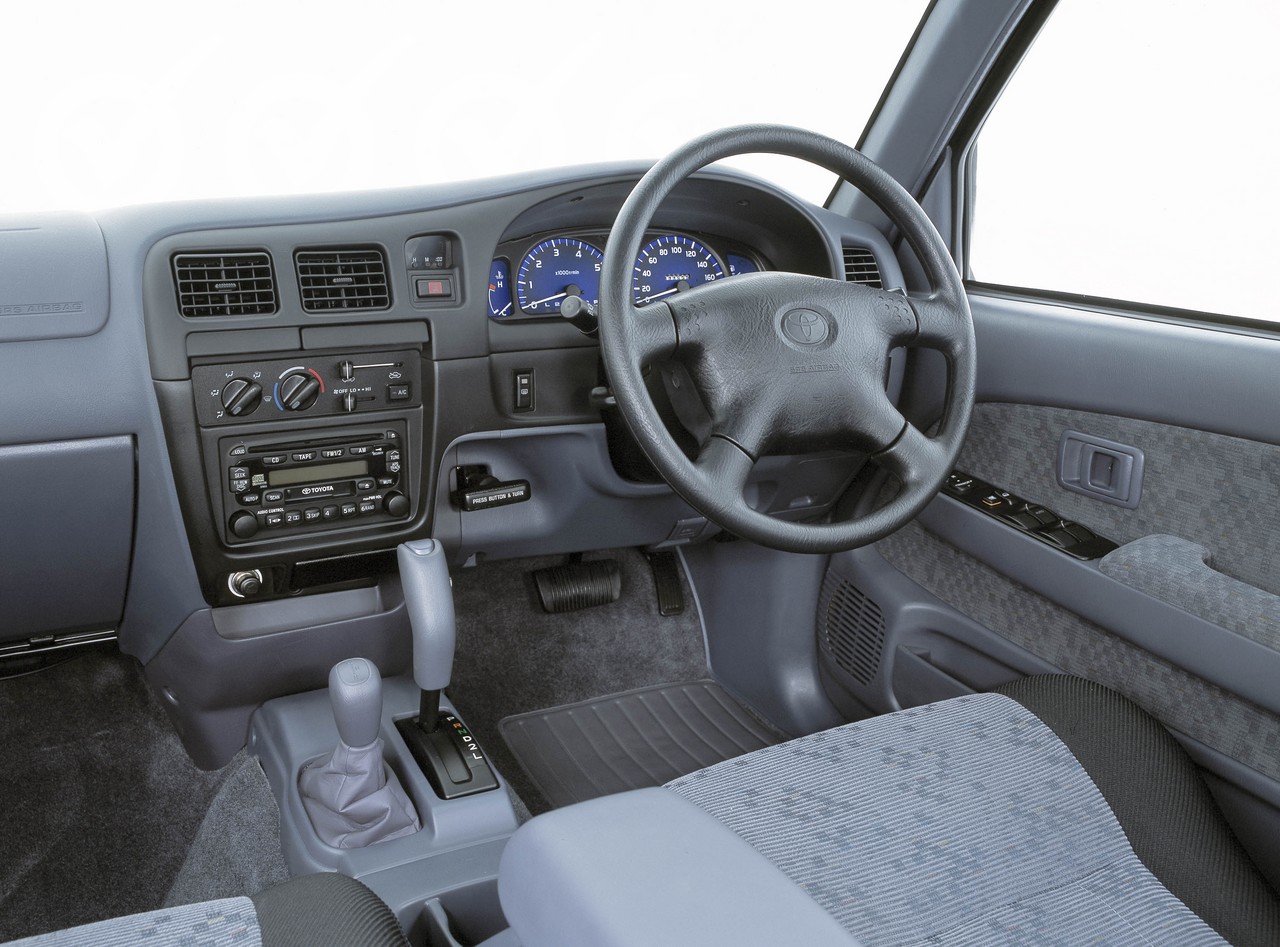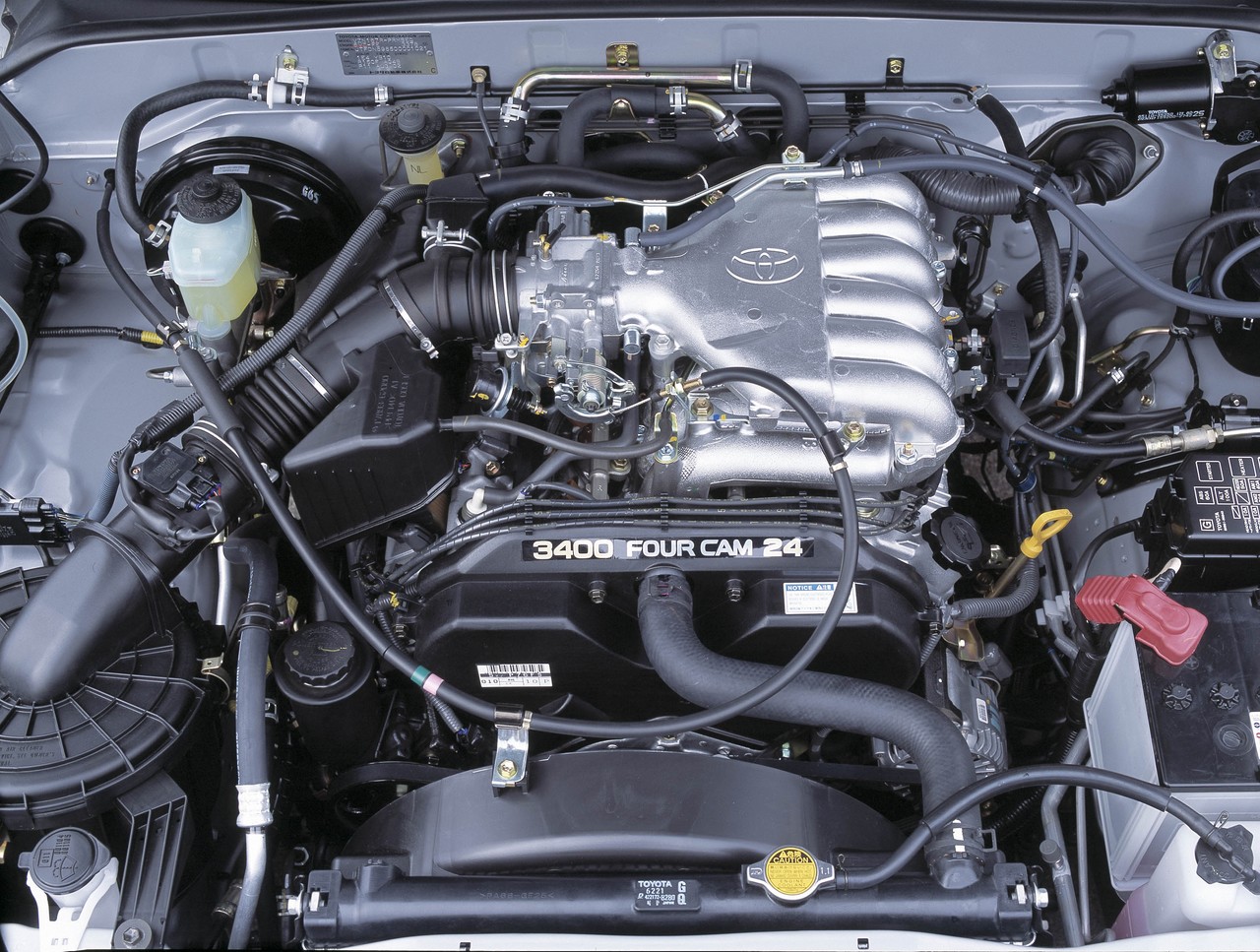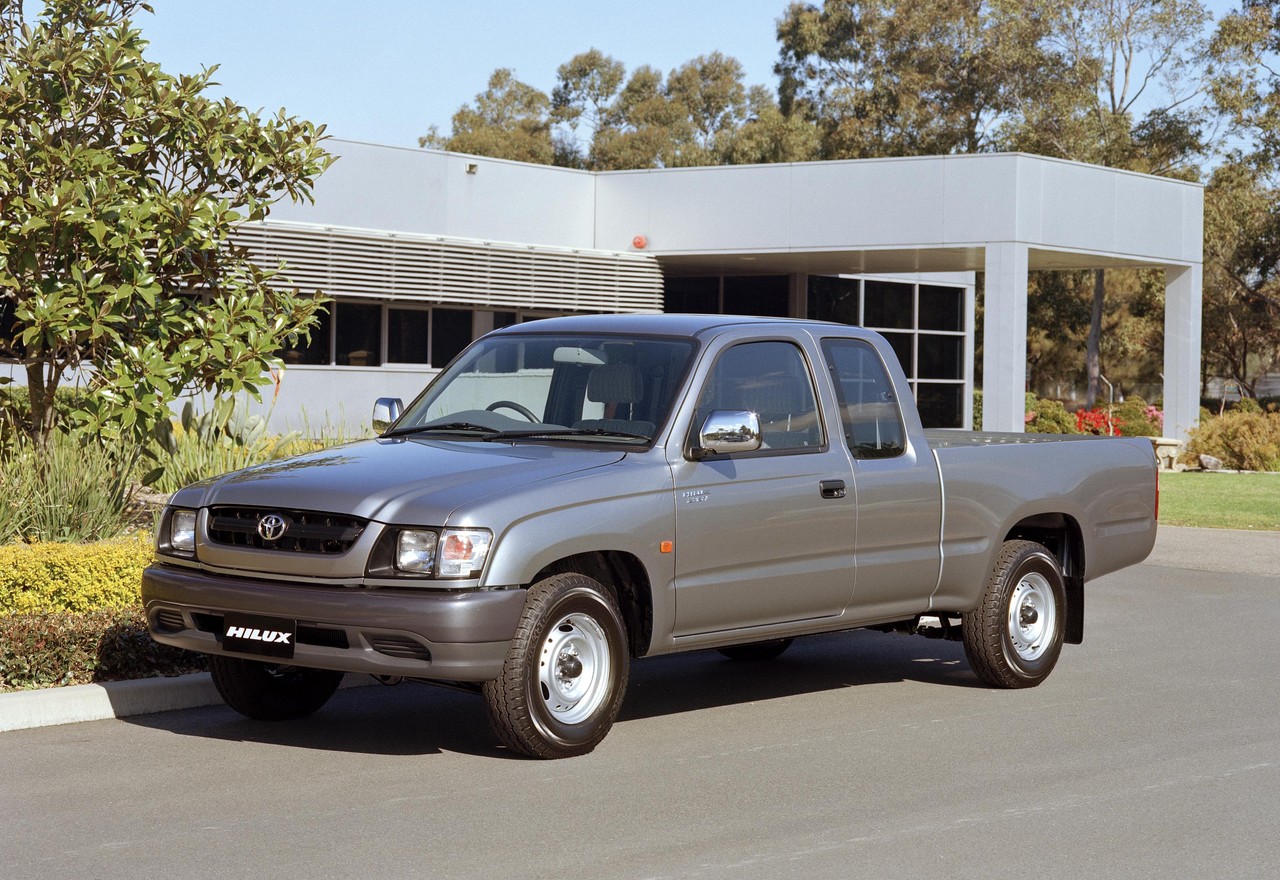
- Responsive and economical 3.0-litre 1KZ-TE turbo-diesel engine
- Spacious cabin
- High standard of fit and finish
- Suspension lacks compliance when unladen
- Ponderous dynamics
- Vague steering
- Front seats lack support
- 3.4-litre 5VZ-FE petrol engine lacks refinement
- 1KZ-TE turbo-diesel engine susceptible to overheating and cracked cylinder heads
Review: Toyota Mk.6-I Hilux utility (1997-01)
Overview
Released in October 1997, the Toyota Mark 6 Series I (Mk.6-I) Hilux utility was available in single cab, extended cab (‘Xtra’) and dual cab bodies. Manufactured in Thailand, the Toyota Mk.6 Hilux was available with 2.0- and 2.7-litre four-cylinder petrol engines or 3.0-litre diesel and turbo-diesel engines.
The Toyota Mk.6-I Hilux range consisted of three variants: the entry-level Workmate, mid-range (Standard or simply ‘Hilux’) and range-topping SR5. The full range is given in the tables below.
Engines
Of the engines,
- The 2.0-litre 1RZ-E four-cylinder petrol engine had electronic fuel injection, a single overhead camshaft, two valves per cylinder and a compression ratio of 9.0:1;
- The 2.7-litre 3RZ-FE four-cylinder petrol engine had sequential multi-point fuel injection, double overhead camshafts, four valves per cylinder and a compression ratio of 9.5:1;
- The 3.0-litre 5L four-cylinder diesel engine, indirect injection, single overhead camshaft, two valves per cylinder and a compression ratio of 22.2:1. In November 2000, the 5L engine was replaced by the 5L-E unit which had electronic fuel injection; and,
- The 3.0-litre 1KZ-TE four-cylinder turbo-diesel engine, indirect electronic fuel injection, a single overhead camshaft, two valves per cylinder and a compression ratio of 21.2:1.
Transmission options consisted four-speed A340E automatic or five-speed manual units (G52, G54, W56 and R151F).
Suspension and steering
The Toyota Mk.6 Hilux had independent, double wishbone front suspension with a lower mounted torsion bar spring and leaf-spring rigid axle rear suspension. Furthermore, the Hilux had recirculating ball type steering; for the Standard and SR5 variants, the steering had engine-speed sensitive power assistance.
| Single cab | Extra cab | Dual cab | ||||||
|---|---|---|---|---|---|---|---|---|
| Variant | Work-mate, STD 4×2 |
STD 4×4 |
STD 4×2 |
STD 4×4 |
STD 4×2 |
STD 4×4 |
SR5 4×2 |
SR5 4×4 |
| Wheelbase (mm) | 2850 | 2860 | 3085 | 3095 | 2850 | 2860 | 2850 | 2860 |
| Length (mm) | 4725 | 4725 | 5100 | 5100 | 4725 | 4725 | 4855 | 4855 |
| Width (mm) | 1690 | 1690 | 1690 | 1690 | 1690 | 1690 | 1690 | 1700 |
| Height (mm) | 1605 | 1780 | 1610 | 1770 | 1630 | 1810 | 1625 | 1805 |
| Tray length (mm) | 2160 | 2160 | 1855 | 1855 | 1355 | 1355 | 1355 | 1355 |
| Tray width (mm) | 1465 | 1465 | 1450 | 1450 | 1465 | 1465 | 1465 | 1465 |
| Tray height (mm) | 405 | 405 | 405 | 405 | 405 | 405 | 405 | 405 |
| Ground clearance (mm) | 200 | 225 | 200 | 225 | 200 | 225 | 200 | 225 |
| Maximum braked towing capacity (kg) | 1800 | 1800 | 1800 | 1800 | 1800 | 1800 | 1800 | 1800 |
| Cab | Engine | Variant | Drive | Trans. | Peak power | Peak torque |
|---|---|---|---|---|---|---|
| Single cab | 2.0-litre I4 (1RZ-E) |
Workmate | RWD | 5sp man. | 80 kW at 5200 rpm | 166 Nm at 2800 rpm |
| 2.7-litre I4 (3RZ-FE) |
Standard | RWD | 4sp auto, 5sp man. |
108 kW at 4800 rpm | 235 Nm at 4000 rpm | |
| 4WD | 5sp man. | |||||
| 3.0-litre diesel I4 (5L) |
Standard | RWD, 4WD | 5sp man. | 65 kW at 4000 rpm | 197 Nm at 2400 rpm | |
| 3.0-litre diesel I4 (5L-E) |
Standard | RWD, 4WD | 5sp man. | 71 kW at 4000 rpm | 200 Nm at 2600 rpm | |
| 3.0-litre turbo-diesel I4 (1KZ-TE) |
Standard, SR5 |
4WD | 5sp man. | 85 kW at 3600 rpm | 295 Nm at 2400 rpm; 315 Nm at 2000 rpm | |
| Extra cab | 2.7-litre I4 (3RZ-FE) |
Standard | RWD | 4sp auto, 5sp man. |
108 kW at 4800 rpm | 235 Nm at 4000 rpm |
| 4WD | 5sp man. | |||||
| 3.0-litre diesel I4 (5L) |
Standard | 4WD | 5sp man. | 65 kW at 4000 rpm | 197 Nm at 2400 rpm | |
| 3.0-litre diesel I4 (5L-E) |
Standard | 4WD | 5sp man. | 71 kW at 4000 rpm | 200 Nm at 2600 rpm | |
| Dual cab | 3.0-litre turbo-diesel I4 (1KZ-TE) |
Standard | RWD, 4WD |
5sp man. | 85 kW at 3600 rpm | 295 Nm at 2400 rpm; 315 Nm at 2000 rpm |
| SR5 | RWD |
Safety equipment
For all Mk.6-I Hilux Standard and SR5 models, safety equipment such as front passenger airbags, ABS and front seatbelts with pretensioners and load limiters were optional.
Brakes
The Hilux 4×2 had 257 mm ventilated front disc brakes with two-piston fixed calipers and 270 mm rear drum brakes. The Hilux 4×4, however, had 289 mm ventilated front disc brakes (with two-piston fixed calipers) and 295 mm rear drum brakes.
ANCAP crash testing
In ANCAP crash testing , a rear-wheel drive Hilux single cab fitted with a 2.7-litre petrol engine received a three star adult occupant protection rating with a score of 19.69. In the offset crash test, protection from serious head and neck injury was poor for the driver, with a risk of life-threatening head injury greater than 50 per cent; chest protection was also marginal for both front occupants. In the side impact, there was a moderate risk of a life-threatening head injury for the driver.
Features: Hilux Workmate, Standard and SR5
Standard features for the Hilux Workmate included a two speaker sound system with an AM/FM radio and cassette player, front bench seat and vinyl seat trim.
The Standard variant was further equipped with a driver’s bucket seat, cloth seat trim, variable intermittent wipers, separate front headrests and a tilt adjustable steering wheel. Beyond this, Extra and Dual Cab models added front bucket seats and a rear window demister; while Extra cab models had a rear jump seat, Dual Cab models had rear bench seats.
The Hilux SR5 was distinguished by its lockable glovebox, remote fuel lid release, digital dashboard clock, power windows and power door locks (i.e. central locking); 4×4 models were also fitted with 15-inch alloy wheels and power mirrors. Visually, the SR5 could be identified by its: chrome plating package which included the front and rear bumpers, radiator grille, door mirrors, door handles and windscreen mouldings.
November 2000: Hilux update
In November 2000, the 3.0-litre turbo-diesel engine was upgraded with its peak torque increasing from 295 Nm to 315 Nm at 2000 rpm. The SR5 was also fitted with a new high-grade 3-in-1 audio unit with a 2DIN-size audio head unit with a single CD player.
The SR5 dual cab was also fitted with side steps.
Related links
- Press Release: Toyota Mk.6-I Hilux utility – turbo-diesel engine (December 1999)
- Press Kit: Toyota Mk.6-I Hilux update (December 2000)
Review: Toyota Mk.6-II Hilux utility (2001-02)
Overview
Released in October 2001, the Mark 6 Series II (Mk.6-II) Hilux utility introduced updated styling, minor equipment changes and discounted pricing.
Visually, the Mk.6-II Hilux could be identified by its new front mask, with new radiator grille, bumper, bonnet and headlight surrounds. Inside, there was a redesigned instrument cluster, new seat upholstery and a passenger vanity mirror. The SR5 was further differentiated by its chrome radiator grille, sculpted multi-reflector headlamps, chrome front bumper, new tailgate and combination tail-lights.
| Cab | Engine | Variant | Drive | Trans. | Peak power | Peak torque |
|---|---|---|---|---|---|---|
| Single cab | 2.0-litre I4 (1RZ-E) |
Workmate | RWD | 5sp man. | 80 kW at 5200 rpm | 166 Nm at 2800 rpm |
| 2.7-litre I4 (3RZ-FE) |
Standard | RWD | 4sp auto, 5sp man. |
108 kW at 4800 rpm | 235 Nm at 4000 rpm | |
| 4WD | 5sp man. | |||||
| 3.0-litre diesel I4 (5L-E) |
Standard | RWD, 4WD | 5sp man. | 71 kW at 4000 rpm | 200 Nm at 2600 rpm | |
| 3.0-litre turbo-diesel I4 (1KZ-TE) |
Standard, SR5 |
4WD | 5sp man. | 85 kW at 3600 rpm | 295 Nm at 2400 rpm; 315 Nm at 2000 rpm | |
| Extra cab | 2.7-litre I4 (3RZ-FE) |
Standard | RWD | 4sp auto, 5sp man. |
108 kW at 4800 rpm | 235 Nm at 4000 rpm |
| 4WD | 5sp man. | |||||
| 3.0-litre diesel I4 (5L-E) |
Standard | 4WD | 5sp man. | 71 kW at 4000 rpm | 200 Nm at 2600 rpm | |
| Dual cab | 3.0-litre turbo-diesel I4 (1KZ-TE) |
Standard | RWD, 4WD |
5sp man. | 85 kW at 3600 rpm | 295 Nm at 2400 rpm; 315 Nm at 2000 rpm |
| SR5 | RWD |
Features
All 2.7-litre petrol models were fitted with a tachometer, while a 70 amp alternator was standard across the range (previously 55 amp).
SR5 variants were also fitted multi-spoke alloy wheels (four-wheel drive models only), a four speaker sound system, power antenna and keyless entry.
Related links
Review: Toyota Mk.6-III Hilux utility (2002-04)
Overview
Released in October 2002, the Mark 6 Series III (Mk.6-III) Hilux utility introduced a revised line-up, a new 3.4-litre 5VZ-FE V6 petrol engine and improved rear suspension settings for four-wheel drive dual cab models. Furthermore, the 2.0-litre four-cylinder engine was discontinued and there were new four-wheel drive 3.0-litre turbo-diesel double cab models.
The 3.4-litre 5VZ-FE engine had a cast iron block, aluminium cylinder heads, double overhead camshafts, sequential multi-port fuel injection, four valves per cylinder and a compression ratio of 9.6:1.
| Cab | Engine | Variant | Drive | Trans. | Peak power | Peak torque |
|---|---|---|---|---|---|---|
| Single cab | 2.7-litre I4 (3RZ-FE) |
Standard | RWD | 5sp man. | 108 kW at 4800 rpm | 235 Nm at 4000 rpm |
| Extra cab | 2.7-litre I4 (3RZ-FE) |
Standard | RWD | 5sp man. | ||
| 3.0-litre diesel I4 (5L-E) |
Standard | 4WD | 5sp man. | 71 kW at 4000 rpm | 200 Nm at 2600 rpm | |
| 3.4-litre V6 (5VZ-FE) | Standard | 4WD | 4sp auto, 5sp man. |
124 kW at 4600 rpm | 291 Nm at 3600 rpm | |
| Dual cab | 2.7-litre I4 (3RZ-FE) |
Standard, SR5 |
RWD | 4sp auto, 5sp man. |
108 kW at 4800 rpm | 235 Nm at 4000 rpm |
| 3.0-litre diesel I4 (5L-E) |
Standard | RWD, 4WD | 5sp man. | 71 kW at 4000 rpm | 200 Nm at 2600 rpm | |
| 3.0-litre turbo-diesel I4 (1KZ-TE) |
Standard, SR5 |
4WD | 5sp man. | 85 kW at 3600 rpm | 315 Nm at 2000 rpm | |
| 3.4-litre petrol V6 (5VZ-FE) | Standard, SR5 |
4WD | 4sp auto, 5sp man. |
124 kW at 4600 rpm | 291 Nm at 3600 rpm |
Features
Features were largely unchanged, though the four-wheel drive dual cab SR5 models were fitted with an alloy sports bar, front sports seats with height and lumbar adjustment and Toyota’s ADD auto front hub system.
Related links
Review: Toyota Mk.6-IV Hilux utility (2004-05)
Overview
Released in September 2004, the Mark 6 Series IV (Mk.6-IV) was a minor update for the Hilux range. As part of the update, the Standard variants were equipped with chrome-plated power mirrors, power windows and door locks.
| Cab | Engine | Variant | Drive | Trans. | Peak power | Peak torque |
|---|---|---|---|---|---|---|
| Single cab | 2.7-litre I4 (3RZ-FE) |
Standard | RWD | 5sp man. | 108 kW at 4800 rpm | 235 Nm at 4000 rpm |
| Extra cab | 2.7-litre I4 (3RZ-FE) |
Standard | RWD | 5sp man. | ||
| 3.0-litre diesel I4 (5L-E) | Standard | 4WD | 5sp man. | 71 kW at 4000 rpm | 200 Nm at 2600 rpm | |
| 3.4-litre V6 (5VZ-FE) | Standard | 4WD | 4sp auto, 5sp man. |
124 kW at 4600 rpm | 291 Nm at 3600 rpm | |
| Dual cab | 2.7-litre I4 (3RZ-FE) |
Standard, SR5 |
RWD | 4sp auto, 5sp man. |
108 kW at 4800 rpm | 235 Nm at 4000 rpm |
| 3.0-litre diesel I4 (5L-E) | Standard | RWD, 4WD | 5sp man. | 71 kW at 4000 rpm | 200 Nm at 2600 rpm | |
| 3.0-litre turbo-diesel I4 (1KZ-TE) | Standard, SR5 |
4WD | 5sp man. | 85 kW at 3600 rpm | 315 Nm at 2000 rpm | |
| 3.4-litre petrol V6 (5VZ-FE) | Standard, SR5 |
4WD | 4sp auto, 5sp man. |
124 kW at 4600 rpm | 291 Nm at 3600 rpm |
Related links
